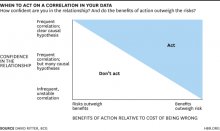Management making decisions
 Not a week goes by without us publishing something here at HBR about the value of data in business. Big data, small data, internal, external, experimental, observational — everywhere we look, information is being captured, quantified, and used to make business decisions.
Not a week goes by without us publishing something here at HBR about the value of data in business. Big data, small data, internal, external, experimental, observational — everywhere we look, information is being captured, quantified, and used to make business decisions.
Not everyone needs to become a quant. But it is worth brushing up on the basics of quantitative analysis, so as to understand and improve the use of data in your business. We’ve created a reading list of the best HBR articles on the subject to get you started.
Why data matters
Companies are vacuuming up data to make better decisions about everything from product development and to hiring. In their 2012 feature on big data, Andrew McAfee and Erik Brynjolfsson describe the opportunity and report that “companies in the top third of their industry in the use of data-driven decision making were, on average, 5% more productive and 6% more profitable than their competitors” even after accounting for several confounding factors.
This shouldn’t come as a surprise, argues McAfee in a pair of recent posts. Data and algorithms have a tendency to outperform human intuition in a wide variety of circumstances.
Picking the right metrics
“There is a difference between numbers and numbers that matter, ” write Jeff Bladt and Bob Filbin in a post from last year. One of the most important steps in beginning to make decisions with data is to pick the right metrics. Good metrics “are consistent, cheap, and quick to collect.” But most importantly, they must capture something your business cares about.
 The difference between analytics and experiments
The difference between analytics and experiments
Data can come from all manner of sources, including customer surveys, business intelligence software, and third party research. One of the most important distinctions to make is between analytics and experiments. The former provides data on what is happening in a business, the latter actively tests out different approaches with different consumer or employee segments and measures the difference in response. For more on what analytics can be used for, read Thomas Davenport’s 2013 HBR article Analytics 3.0. For more on running successful experiments, try these two articles.
Ask the right questions of data
You might also like
Wealth Adviser: Turn Office Assistants into Prospectors — Wall Street Journal
“I had grown weary of upper management making decisions for client-facing advisors pertaining to the tools used and the manner of serving clients,” he writes on ThinkAdvisor.





 Decision making can be regarded as the mental processes (cognitive process) resulting in the selection of a course of action among several alternative scenarios. Every decision making process produces a final choice. The output can be an action or an opinion of choice.
Decision making can be regarded as the mental processes (cognitive process) resulting in the selection of a course of action among several alternative scenarios. Every decision making process produces a final choice. The output can be an action or an opinion of choice.